Hua C., Wong R. Differential Equations and Asymptotic Theory in Mathematical Physics
Подождите немного. Документ загружается.

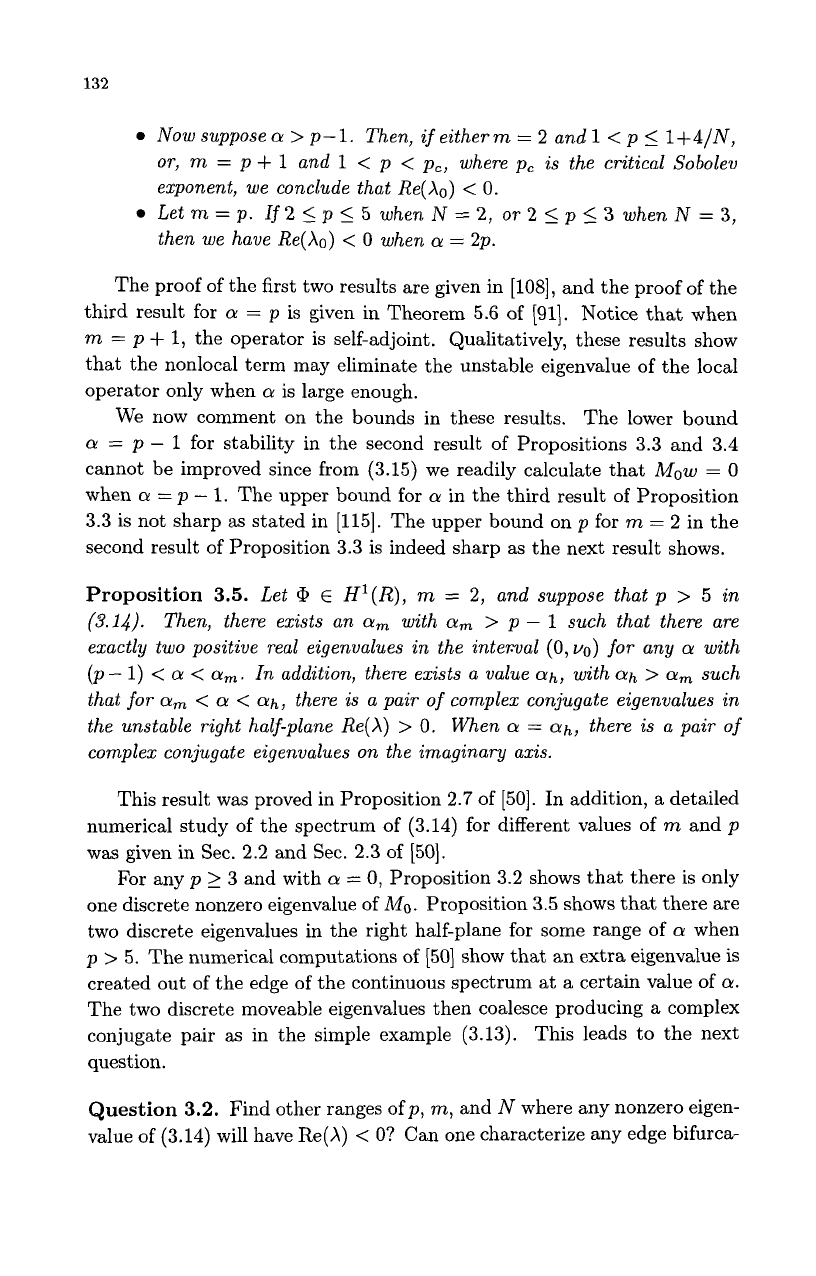
132
Now suppose
a
>
p-1.
Then,
if
either
m
=
2
and
1
<
p
5
1+4/N,
or,
m
=
p
+
1
and
1
<
p
<
p,, where
p,
is the critical Sobolev
exponent, we conclude that Re(Xo)
<
0.
Letm=p. If2915 whenN=2, or21p13 whenN=3,
then we have Re(X0)
<
0
when
a
=
2p.
The proof of the first two results are given in
[108],
and the proof of the
third result for
a
=
p
is given in Theorem
5.6
of
[91].
Notice that when
m
=
p
+
1,
the operator is self-adjoint. Qualitatively, these results show
that the nonlocal term may eliminate the unstable eigenvalue of the local
operator only when
a
is large enough.
We now comment on the bounds in these results. The lower bound
a
=
p
-
1
for stability in the second result of Propositions
3.3
and
3.4
cannot be improved since from
(3.15)
we readily calculate that
Mow
=
0
when
a
=
p
-
1.
The upper bound
for
a
in the third result
of
Proposition
3.3
is not sharp
as
stated in
[115].
The upper bound on
p
for
m
=
2
in the
second result of Proposition
3.3
is indeed sharp as the next result shows.
Proposition
3.5.
Let
E
H1(R),
m
=
2,
and suppose that
p
>
5
in
(3.14).
Then, there exists an
a,
with
a,
>
p
-
1
such that there are
exactly two positive real eigenvalues
in
the interval
(0,vo)
for any
a
with
(p
-
1)
<
a
<
a,.
In addition, there exists a value
ah,
with
ah
>
am
such
that for
am
<
a
<
ah,
there
as
a pair
of
complex conjugate eigenvahes
in
the unstable
right
half-plane Re(X)
>
0.
When
a
=
ah,
there is a pair
of
complex conjugate eigenvalues on the imaginary axis.
This result was proved in Proposition
2.7
of
[50].
In addition, a detailed
numerical study of the spectrum of
(3.14)
for different values of
m
and
p
was
given in Sec.
2.2
and Sec.
2.3
of
[50].
For any
p
2
3
and with
a
=
0,
Proposition
3.2
shows that there is only
one discrete nonzero eigenvalue of
Mo.
Proposition
3.5
shows that there are
two discrete eigenvalues in the right half-plane for some range of
Q
when
p
>
5.
The numerical computations of
[50]
show that an extra eigenvalue is
created out of the edge of the continuous spectrum at a certain value of
a.
The two discrete moveable eigenvalues then coalesce producing
a
complex
conjugate pair
as
in the simple example
(3.13).
This leads to the next
question.
Question
3.2.
Find other ranges of
p,
m,
and
N
where any nonzero eigen-
value of
(3.14)
will have Re(X)
<
O?
Can one characterize any edge bifurca-
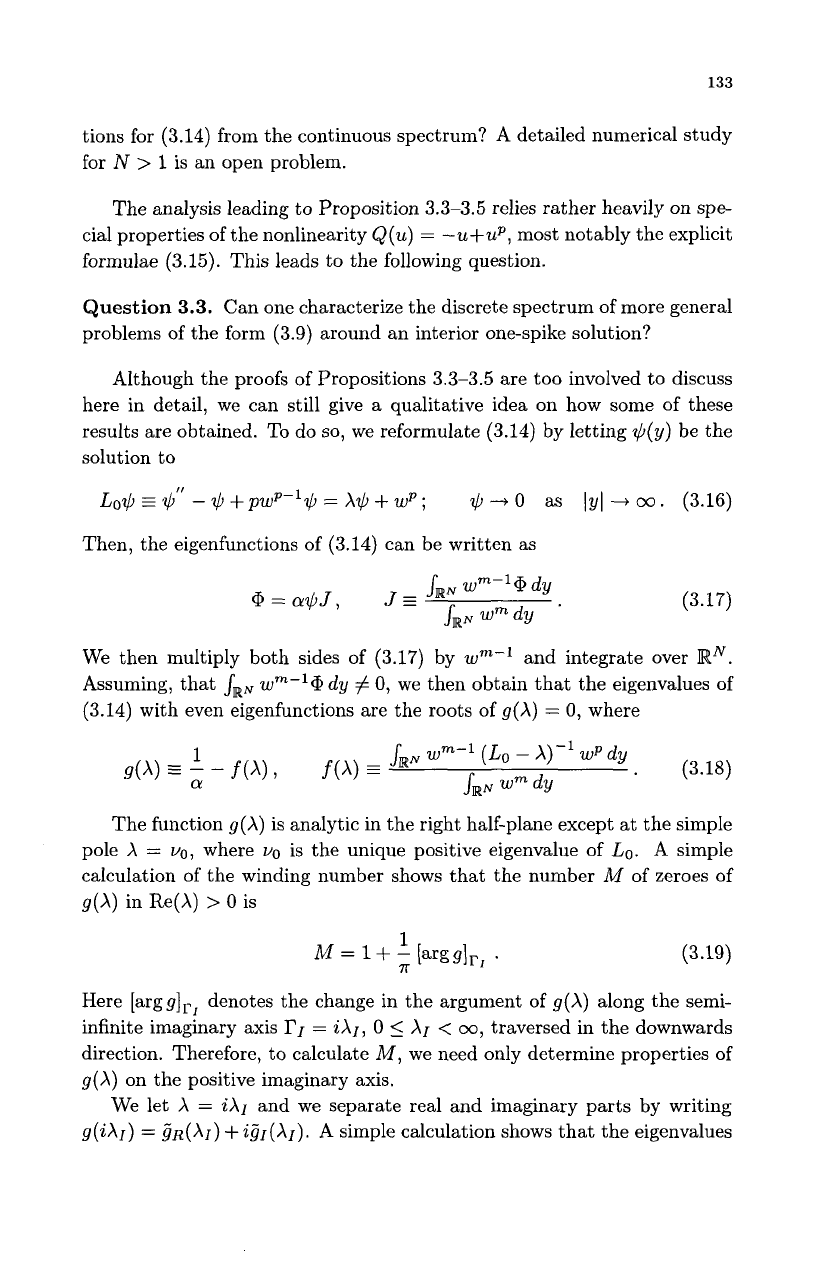
133
tions for
(3.14)
from the continuous spectrum?
A
detailed numerical study
for
N
>
1
is an open problem.
The analysis leading to Proposition
3.3-3.5
relies rather heavily on spe-
cial properties of the nonlinearity
Q(u)
=
-u+uP,
most notably the explicit
formulae
(3.15).
This leads to the following question.
Question
3.3.
Can one characterize the discrete spectrum of more general
problems of the form
(3.9)
around an interior one-spike solution?
Although the proofs of Propositions
3.3-3.5
are too involved to discuss
here in detail, we can still give a qualitative idea on how some of these
results are obtained. To do
so,
we reformulate
(3.14)
by letting
$(y)
be the
solution to
Lo$
=
$"
-
$
+pwP-'$
=
A$
+
wp
;
$3
0
a~
IyI
4
00.
(3.16)
Then, the eigenfunctions of
(3.14)
can be written as
(3.17)
We then multiply both sides of
(3.17)
by
wm-'
and integrate over
RN.
Assuming, that
SRN
wm-'@ dy
#
0,
we then obtain that the eigenvalues of
(3.14)
with even eigenfunctions are the roots
of
g(X)
=
0,
where
The function
g(X)
is analytic in the right half-plane except at the simple
pole
X
=
vo,
where
vo
is the unique positive eigenvalue of
Lo.
A
simple
calculation of the winding number shows that the number
A4
of zeroes of
g(X)
in Re(X)
>
0
is
(3.19)
Here [argglr1 denotes the change in the argument of
g(X)
along the semi-
infinite imaginary axis
l?I
=
iXI,
0
<
XI
<
00,
traversed in the downwards
direction. Therefore, to calculate
M,
we need only determine properties of
g(X)
on the positive imaginary axis.
We let
X
=
XI
and we separate real and imaginary parts by writing
g(iXI)
=
~R(XI)
+
iaj(X~).
A
simple calculation shows that the eigenvalues
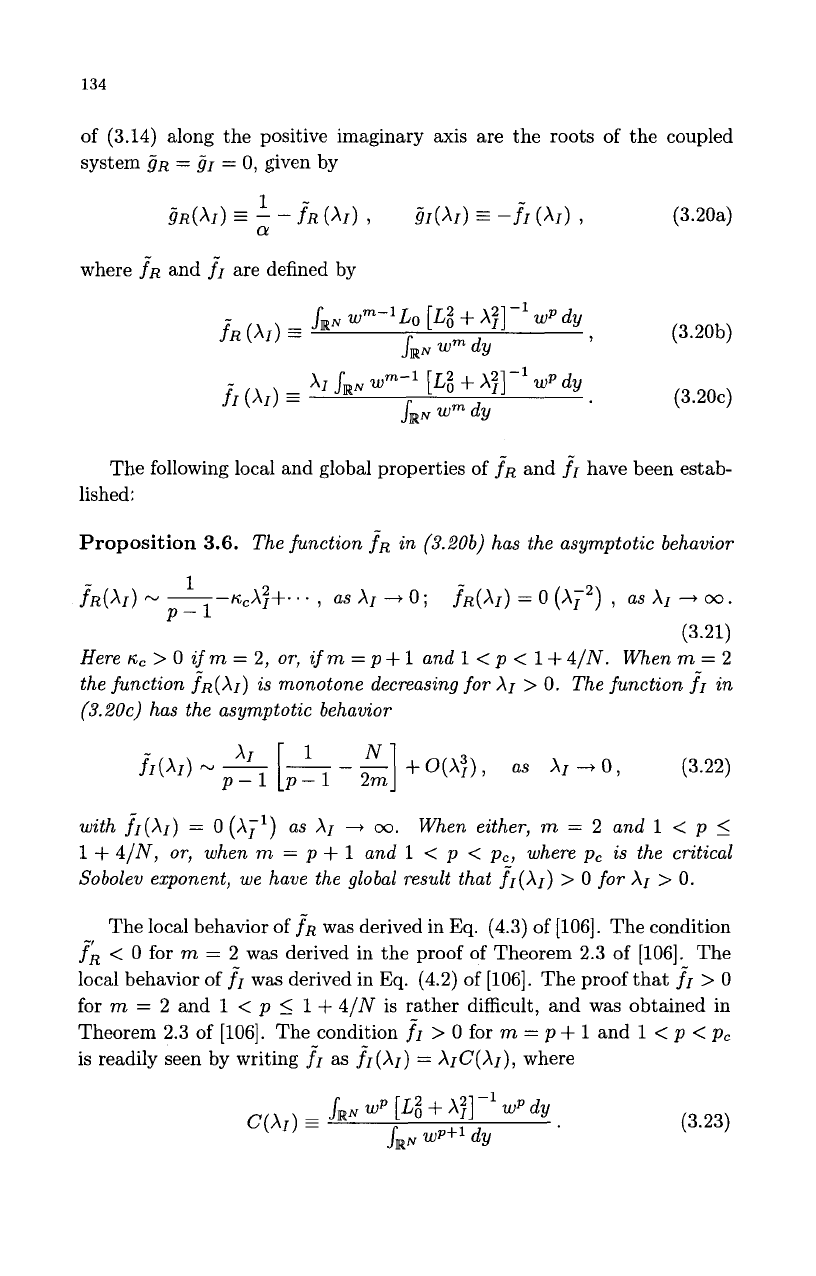
134
of (3.14) along the positive imaginary axis are the roots of the coupled
system
j~
=
51
=
0,
given by
(3.20a)
1
sR(xI)
=
-
-
f~
(XI)
,
and
f~
are defined by
ir(~I)
E
-?I
(XI)
,
a
where
The following local and global properties of
f~
and
f~
have been estab-
lished:
Proposition
3.6.
The function
f~
in
(3.2Ob) has the asymptotic behavior
&,A:+.
. .
,
as
XI
---t
0;
~R(xI)
=
o
(AT')
,
as
XI
4
00.
~R(xI)
N
--
(3.21)
Here
6,
>
0
if
m
=
2,
or,
if
m
=p+l and
1
<p
<
1+4/N.
Whenm
=
2
the function
~R(XI)
is monotone decreasing
for
XI
>
0.
The function
f~
in
(3.20~) has the asymptotic behavior
1
P-1
with
~I(XI)
=
0
(A;')
as
XI
+
00.
When either,
m
=
2
and
1
<
p
5
1
+
4/N,
or, when
m
=
p
+
1
and 1
<
p
<
p,, where p, is the critical
Sobolev exponent, we have the global result that
~I(XI)
>
0
for
XI
>
0.
The local behavior of
f~
was derived in
Eq.
(4.3)
of
[106].
The condition
f;
<
0
for
m
=
2 was derived in the proof of Theorem 2.3 of
[106].
The
local behavior off1 was derived in
Eq.
(4.2) of
[106].
The proof that
f~
>
0
for
m
=
2
and
1
<
p
5
1
+
4/N is rather difficult, and was obtained in
Theorem 2.3 of
[106].
The condition
fI
>
0
for
m
=
p
+
1
and
1
<
p
<
pc
is readily seen by writing
f~
as
f~((x,)
=
XIC(XI),
where
-
(3.23)
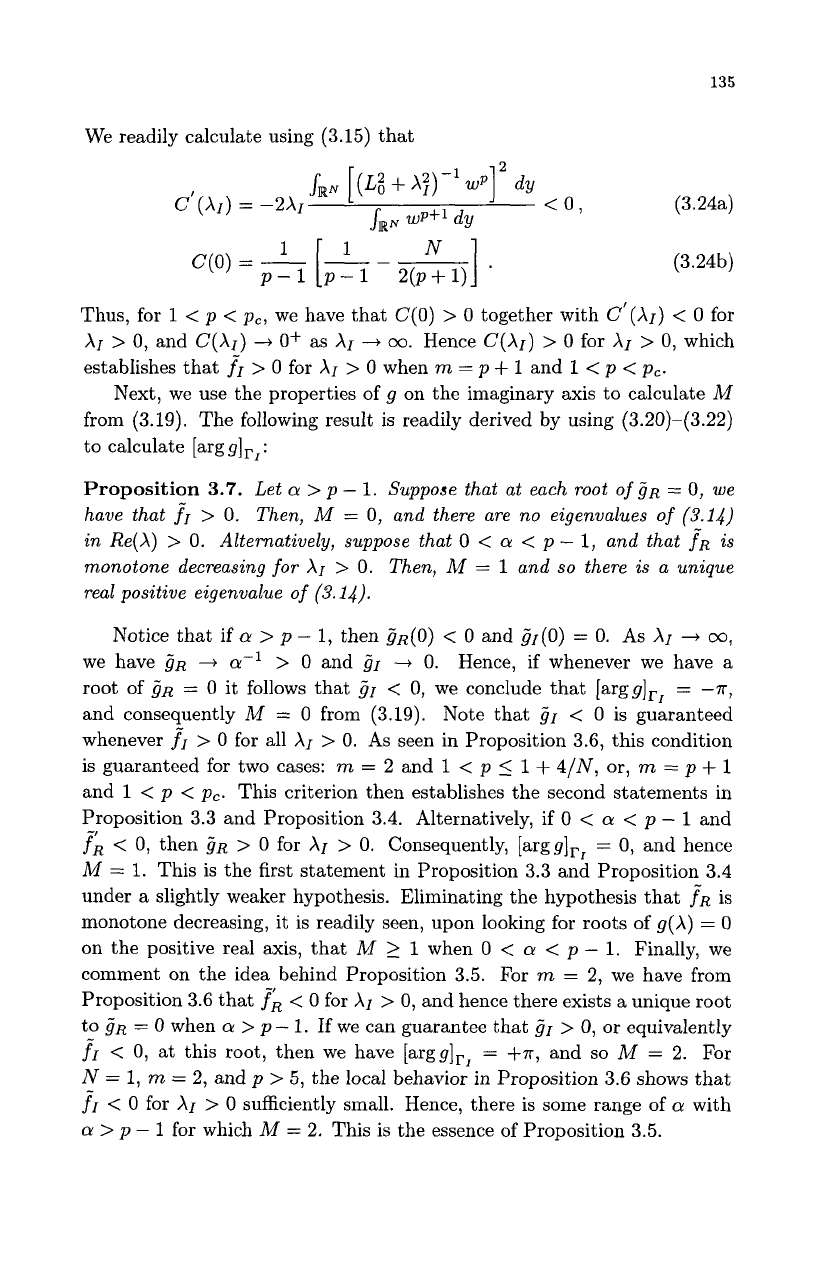
135
We readily calculate using (3.15) that
C(O)=-
P-1
l"
P-1
2(p+1)
"1
(3.24a)
(3.24b)
Thus, for
1
<
p
<
p,,
we have that
C(0)
>
0
together with
C'(X1)
<
0
for
XI
>
0,
and
C(X1)
+
O+
as
XI
-+
00.
Hence
C(X1)
>
0
for
XI
>
0,
which
establishes that
f;
>
0
for
XI
>
0
when
m
=
p
+
1
and
1
<
p
<
p,.
Next, we use the properties of g on the imaginary axis to calculate
M
from (3.19). The following result is readily derived by using (3.20)-(3.22)
to calculate [arg gIr,
:
Proposition
3.7.
Let
a
>
p
-
1.
Suppose that at each root
of
6~
=
0,
we
have that
f~
>
0.
Then,
M
=
0,
and there are no eigenualues
of
(3.14)
in
Re(X)
>
0.
Alternatively, suppose that
0
<
a
<
p
-
1,
and that
f~
is
monotone decreasing for
XI
>
0.
Then,
M
=
1
and
so
there is a unique
real positive eigenualue
of
(3.14).
Notice that if
a
>
p
-
1,
then
ij~(0)
<
0
and
Gl(0)
=
0.
As
A1
+
00,
we have
ij~
-+
a-'
>
0
and
61
4
0.
Hence, if whenever we have a
root of
ij~
=
0
it follows that
51
<
0,
we conclude that [argglr1
=
-r,
and consequently
M
=
0
from (3.19). Note that
61
<
0
is guaranteed
whenever
f;
>
0
for all
XI
>
0.
As
seen in Proposition 3.6, this condition
is guaranteed for two cases:
m
=
2
and
1
<
p
5
1
+
4/N,
or,
m
=
p
+
1
and
1
<
p
<
p,.
This criterion then establishes the second statements in
Proposition 3.3 and Proposition
3.4.
Alternatively, if
0
<
a
<
p
-
1
and
fk
<
0,
then
ij~
>
0
for
XI
>
0.
Consequently, [arggIrr
=
0,
and hence
M
=
1. This is the first statement in Proposition 3.3 and Proposition
3.4
under
a
slightly weaker hypothesis. Eliminating the hypothesis that
FR
is
monotone decreasing, it is readily seen, upon looking for roots of g(X)
=
0
on the positive real axis, that
M
2
1
when
0
<
a
<
p
-
1.
Finally, we
comment on the idea behind Proposition 3.5. For
m
=
2, we have from
Proposition 3.6 that
fk
<
0
for
XI
>
0,
and hence there exists a unique root
to
ij~
=
0
when
a
>
p
-
1.
If we can guarantee that
tjr
>
0,
or equivalently
f~
<
0,
at this root, then we have [arggIrI
=
+7r,
and
so
M
=
2. For
N
=
1,
m
=
2, and
p
>
5, the local behavior in Proposition 3.6 shows that
.f~
<
0
for
XI
>
0
sufficiently small. Hence, there
is
some range of
a
with
a
>
p
-
1
for which
M
=
2. This is the essence of Proposition 3.5.

136
The result in Proposition 3.7 gives a simple criterion to determine
suffi-
cient conditions for nonzero eigenvalues
of
(3.14) to satisfy Re(X)
<
0.
This
leads to the following question.
Question
3.4.
Can one find other ranges of
m,
p,
and
N,
to ensure that
the positivity condition on
f~
given in Proposition 3.7 holds? With this
condition any nonzero eigenvalue of (3.14) has Re(X)
<
0
when
(Y
>
p
-
1.
One of the earliest analyses of metastability for
a
shadow system was
given in [64]. Another activator-inhibitor system that exhibits metastability
was given in [5] and [6]. In the next few subsections we give a few explicit
examples of the stability and dynamics of spikes for shadow systems.
3.1.
The Shadow Gierer-Meinhardt Model
Our first example of a shadow system is obtained by letting
D
-+
m
in the
GM
model (1.1) to get
at
=
E2Aa
-
a
+
ap/hq, x
E
R
;
&a
=
0,
x
E
dR
,
(3.25a)
E-~
am
Tht
=
-h+
IR(
Fdx.
(3.25b)
In (3.25b),
Is11
denotes the volume of
0.
In this section we will consider the
case where the reaction-time constant
T
in (3.25b) is zero. The possibility
of Hopf bifurcations when
T
>
0
is discussed in the next section.
An interior one-spike equilibrium solution to (3.25) in
RN
is given by
Here
C
is given in (1.2),
WN
is the surface area of the unit N-dimensional
sphere, and
w(p)
satisfies (1.7).
The finite-domain nonlocal eigenvalue
problem of the form (3.8), obtained by linearizing (3.25) around this equi-
librium solution, is
where
an&
=
0
on
dR.
The corresponding infinite-line nonlocal eigenvalue
problem is
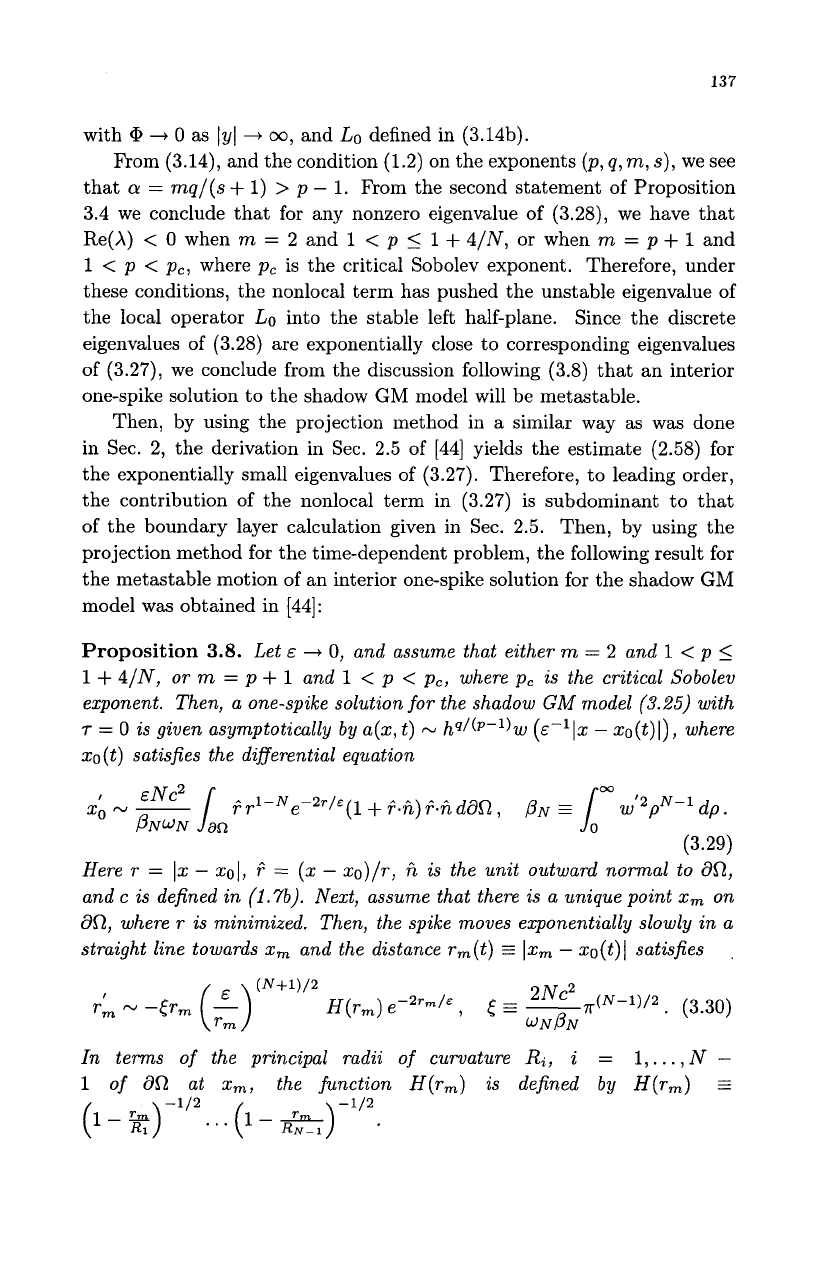
137
with
From
(3.14),
and the condition
(1.2)
on the exponents
(p,
q,
m,
s),
we see
that
Q
=
mq/(s
+
1)
>
p
-
1.
From the second statement of Proposition
3.4
we conclude that for any nonzero eigenvalue of
(3.28),
we have that
Re(X)
<
0
when
m
=
2
and
1
<
p
5
1
+
4/N,
or when
m
=
p
+
1
and
1
<
p
<
p,,
where
p,
is the critical Sobolev exponent. Therefore, under
these conditions, the nonlocal term has pushed the unstable eigenvalue of
the local operator
LO
into the stable left half-plane. Since the discrete
eigenvalues of
(3.28)
are exponentially close to corresponding eigenvalues
of
(3.27),
we conclude from the discussion following
(3.8)
that an interior
one-spike solution to the shadow
GM
model will be metastable.
Then, by using the projection method in a similar way as was done
in Sec.
2,
the derivation in Sec.
2.5
of [44] yields the estimate
(2.58)
for
the exponentially small eigenvalues of
(3.27).
Therefore, to leading order,
the contribution of the nonlocal term in
(3.27)
is subdominant to that
of the boundary layer calculation given in Sec.
2.5.
Then, by using the
projection method for the time-dependent problem, the following result for
the metastable motion of an interior one-spike solution for the shadow
GM
model was obtained in [44]:
+
0
as
IyI
4
00,
and
LO
defined in (3.14b).
Proposition
3.8.
Let
E
+
0,
and assume that either
m
=
2
and
1
<
p
5
1
+
4/N1 or
m
=
p
+
1
and
1
<
p
<
pc, where p, is the critical Sobolev
exponent. Then, a one-spike solution for the shadow
GM
model
(3.25)
with
T
=
0
is given asymptotically by
a(x,
t)
N
hq/(P-l)w
(E-~I
x
-
xo(t)l),
where
x:o(t)
satisfies the differential equation
Here
r
=
1x
-
201,
?
=
(x
-
xo)/r,
fi
is the unit outward normal to
dR,
and
c
is defined
in
(1.7b). Next, assume that there is a unique point
x,
on
dR,
where
r
is minimized. Then, the spike moves exponentially slowly
in
a
straight line towards
x,
and the distance
rm(t)
E
12,
-
xo(t)l
satisfies
.
In
terms
of
the principal radii of curvature
Ri,
i
=
1,.
. .
,
N
-
1
of
dR
at
x,,
the function H(r,) is defined by H(r,)
=
-1/2
-1/2
(1-2)
.+&)
.
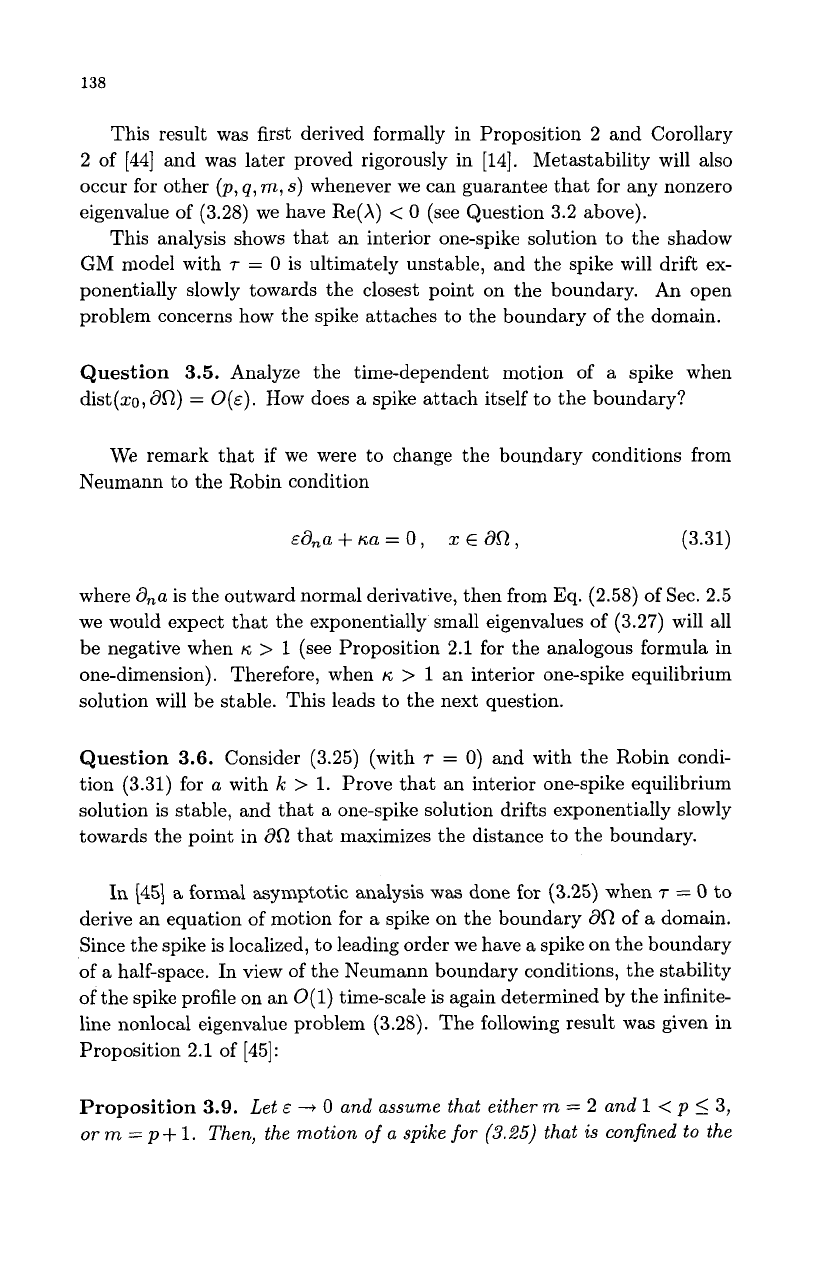
138
This result was first derived formally in Proposition
2
and Corollary
2
of
[44]
and was later proved rigorously in
[14].
Metastability will also
occur for other
(p,
q,
m,
s)
whenever we can guarantee that for any nonzero
eigenvalue of
(3.28)
we have Re(X)
<
0
(see Question
3.2
above).
This analysis shows that an interior one-spike solution to the shadow
GM
niodel with
T
=
0
is ultimately unstable, and the spike will drift ex-
ponentially slowly towards the closest point on the boundary. An open
problem concerns how the spike attaches to the boundary of the domain.
Question
3.5.
Analyze the time-dependent motion of a spike when
dist(z0,aR)
=
O(E).
How does
a
spike attach itself to the boundary?
We
remark that if we were to change the boundary conditions from
Neumann to the Robin condition
Edna+Ka=O,
z~dR,
(3.31)
where
&a
is the outward normal derivative, then from Eq.
(2.58)
of Sec.
2.5
we would expect that the exponentially small eigenvalues of
(3.27)
will all
be negative when
ri
>
1
(see Proposition
2.1
for the analogous formula in
one-dimension). Therefore, when
K
>
1
an interior one-spike equilibrium
solution will be stable. This leads to the next question.
Question
3.6.
Consider
(3.25)
(with
T
=
0)
and with the Robin condi-
tion
(3.31)
for
a
with
k
>
1.
Prove that an interior one-spike equilibrium
solution is stable, and that a one-spike solution drifts exponentially slowly
towards the point in
dR
that maximizes the distance to the boundary.
In
[45]
a
formal asymptotic analysis
was
done for
(3.25)
when
T
=
0
to
derive an equation of motion for a spike on the boundary
dR
of
a
domain.
Since the spike is localized, to leading order we have a spike on the boundary
of a half-space. In view of the Neumann boundary conditions, the stability
of the spike profile on an
O(
1)
time-scale is again determined by the infinite-
line nonlocal eigenvalue problem
(3.28).
The following result was given in
Proposition
2.1
of
[45]:
Proposition
3.9.
Let
E
-+
0
and
assume that either
m
=
2
and
1
<
p
5
3,
or
m
=
p+
1.
Then, the motion
of
a
spike
for
(3.25)
that
is
confined
to
the
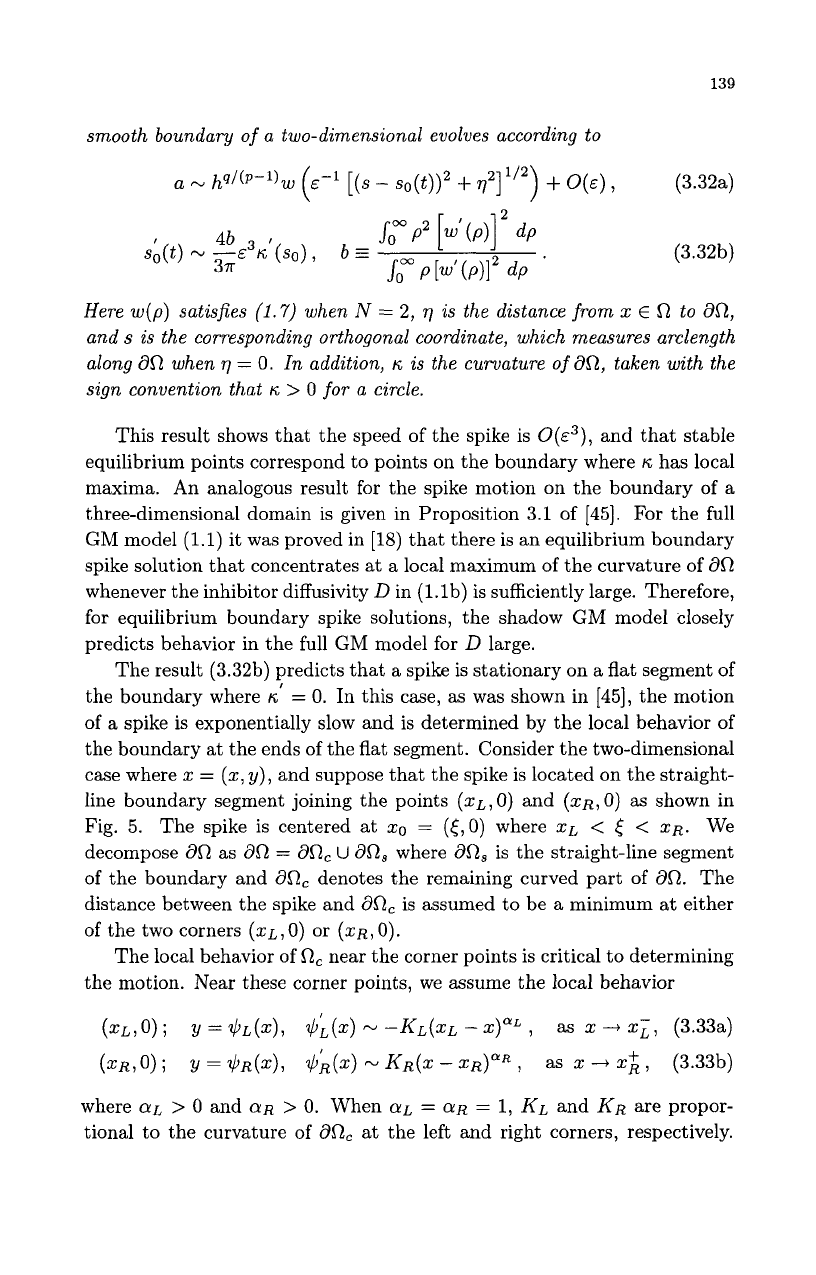
139
smooth boundary
of
a two-dimensional evolves according to
(3.32a)
(3.32b)
Here
w(p)
satisfies
(1.7)
when
N
=
2,
Q
is the distance from
x
E
R
to
dR,
and
s
is
the corresponding orthogonal coordinate, which measures arclength
along
dR
when
II
=
0.
In addition,
K
is the curvature
of
dR,
taken with the
sign convention that
K
>
0
for a circle.
This result shows that the speed
of
the spike is O(E~), and that stable
equilibrium points correspond to points on the boundary where
K
has local
maxima. An analogous result for the spike motion on the boundary
of
a
three-dimensional domain is given in Proposition 3.1 of [45]. For the full
GM model (1.1) it was proved in
[18)
that there is an equilibrium boundary
spike solution that concentrates at
a
local maximum of the curvature
of
dR
whenever the inhibitor diffusivity
D
in (l.lb) is sufficiently large. Therefore,
for equilibrium boundary spike solutions, the shadow GM model closely
predicts behavior in the full GM model for
D
large.
The result (3.32b) predicts that a spike is stationary on
a
flat
segment of
the boundary where
K’
=
0.
In this case, as was shown in
[45],
the motion
of
a
spike
is
exponentially slow and is determined by the local behavior
of
the boundary at the ends of the flat segment. Consider the two-dimensional
case where
z
=
(x,
y),
and suppose that the spike is located on the straight-
line boundary segment joining the points
(x~,0)
and
(zR,~)
as
shown in
Fig. 5.
The spike
is
centered at
xo
=
(6,O)
where
XL
<
E
<
ZR.
We
decompose
dR
as
OR
=
80,
u
dR,
where
do,
is the straight-line segment
of
the boundary and
do,
denotes the remaining curved part of
80.
The
distance between the spike and
OR,
is assumed to be
a
minimum at either
of
the two corners
(x~,0)
or
(zR,~).
The local behavior of
R,
near the corner points is critical to determining
the motion. Near these corner points, we assume the local behavior
(ZL,~)
;
+L(x)
N
-KL(ZL
-
x)ar.
,
as
x
-+
51,
(3.33a)
(ZR,
0)
;
y
=
+R(z),
+i(x)
N
KR(X
-
ZR)~~
,
as
x
+
~2,
(3.33b)
where
QL
>
0
and
CYR
>
0.
When
QL
=
QR
=
1,
KL
and
KR
are propor-
tional to the curvature
of
dR,
at
the left and right corners, respectively.
y
=
+L(z),

140
(XL,
0)
(<?
0)
80s
(xR,o)
Figure
5.
The
spike is centered at
z
=
<
on the flat segment. The dotted line indicates an approximate
equipotential
for
a.
Plot
of
a
two-dimensional domain
R
with
a
flat boundary segment.
The following result characterizing the motion of a spike on the flat segment
was derived in Proposition 5.2 of [45] using the projection method.
Proposition
3.10.
Let
E
4
0
and assume that either
m
=
2
and
1
<
p
5
3,
or
m
=
p
+
1.
Assume that the distance between
<
and
80,
is a
minimum
at either
of
the two comers
(XL,
0)
or
(XR,
0).
Then, for
E
0,
the x-coordinate,
<(t),
of
the center
of
a spike that is attached
to
the flat
segment
80,
satisfies the asymptotic differential equation,
Here c is given
in
(1.7b),
p
=
J;;"
pw"(p)
dp, and the constants
KL, KR,
QL
and
QR
are defined
in
(3.33)
in
terms
of
the comer behavior
of
doc.
A
similar differential equation for the motion of a straight-line interface
in
a
constant width neck region of
a
dumbbell-shaped domain was derived
in
[60].
The result (3.34) shows that there is
a
unique steady-state one-
spike boundary solution on
XL
<
<
<
XR
whenever
KL
and
KR
have the
same sign. This solution is unstable when
R
is
convex near
(XL,~)
and
(xR,~)
so
that
KR
<
0 and
KL
<
0.
It
is stable when
KL
>
0 and
KR
>
0.
If
KL
<
0 and KR
>
0,
then there is
no
steady-state and
((t)
will
move exponentially slowly towards
XR.
Similarly,
((t)
will move towards

141
ZL
if
KL
>
0
and
KR
<
0.
When the spike touches
(ZL,~)
or
(ZR,~),
its
subsequent evolution is determined by (3.3210).
Question
3.7.
Give
a
rigorous proof of the characterization of time-
dependent spike motion on the boundary of the domain as given in Propo-
sition 3.9-3.10 above, and in Proposition 3.1 of [45]. Formulate a numerical
method that is able to numerically compute interior and boundary spike
solutions to (3.25) over, possibly, exponentially long time-scales.
3.2.
Hopf Bifurcations for the Shadow
GM
Model
We now analyze (3.25) when
r
>
0.
A
equilibrium one-spike solution is
again given by (3.26). For this shadow
GM
problem, it was shown numeri-
cally in
[78]
that a Hopf bifurcation in the spike amplitude can occur when
r
is large enough. Since this instability occurs on an
0(1)
time-scale, for
this problem we are not concerned with the exponentially small eigenvalues.
By computing the full numerical solution to (3.25) for
N
=
2,
in Fig.
6
we
plot the amplitude
a,
=
a(0,t)
of
a
spike centered at
T
=
1x1
=
0
versus
t
for two values of
r.
This figure suggests that there is
a
Hopf bifurcation
for some
r
in 0.53
<
r
<
0.58.
0.240
,
0.0
10.0
20.0
30.0
40.0
t
Figure
6.
The Hopf bifurcation. We plot
a
at
x
=
0
versus
t
for
T
=
0.53
(solid curve)
and
T
=
0.58
(heavy solid curve). The exponent set
is
(p,
q,
m,
s)
=
(2,1,2,0), with
N
=
2, and
E
=
0.05.
To
analyze the Hopf bifurcation we must study the associated spectral
problem. Upon linearizing (3.25) around the equilibrium solution in (3.26),
